Subscribe to our ▶️ YouTube channel 🔴 for the latest videos, updates, and tips.
Subtraction with Regrouping
We will learn subtraction 4-digit, 5-digit and 6-digit numbers with regrouping.
Subtraction of 4-digit numbers can be done in the same way as we do subtraction of smaller numbers. We first arrange the numbers one below the other in place value columns and then we start subtracting from the ones place and regroup, if required as shown in the following examples.
Solved Examples on Subtraction of 4-Digit Numbers with Regrouping:
1. Subtract 3958 from 7461.
Solution:
|
Step I: Arrange the numbers vertically. Step II: Subtract the ones. Since 8 > 1, we cannot subtract 8 from 1. Regroup 6 tens and 1 one. Now, 6 tens + 1 one = 5 tens and 11 ones. 11 – 8 = 3 ones. Write 3 in ones column. Step III: Subtract the tens. 5 tens – 5 tens = 0 tens. Write 0 in tens column. Step IV: Subtract the hundreds. Since 9 > 4, we cannot subtract 9 from 4. Regroup 7 thousands and 4 hundreds as 6 thousands and 14 hundreds. 14 – 9 = 5 hundreds. Write 5 in hundreds column. Step V: Subtract the thousands. 6 – 3 = 3 thousands. Write 3 in thousands column.
|
Thus, 7461 – 3958 = 3503. |
Subtraction of 4-Digit Numbers with Regrouping Video
Subscribe to our ▶️ YouTube channel 🔴 for the latest videos, updates, and tips.
2. Subtract 2947 from 8163
Solution:
Step I: Arrange the numbers in columns.
|
Th |
H |
T |
O | ||
|
8 |
1 |
6 |
3 | ||
|
- |
2 |
9 |
7 |
4 |
|
|
|
|
|
|
Step II: Subtract the ones. Here 3 < 4, so regroup 6 tens 3 ones as 5 tens and 13 ones.
|
Th |
H |
T |
O | ||
|
|
|
5 |
13 | ||
|
8 |
1 |
|
| ||
|
- |
2 |
9 |
7 |
4 |
|
|
|
|
|
9 |
Step III: Subtract the tens. Here, 5 < 7, so regroup 1 hundred 6 tens as O hundreds and 15 tens.
|
Th |
H |
T |
O | ||
|
15 |
13 | ||||
|
|
0 |
|
| ||
|
8 |
|
|
| ||
|
- |
2 |
9 |
7 |
4 |
|
|
|
|
8 |
9 |
Step IV: Subtract the hundreds. Here, 0 < 9. so regroup 8 thousands 0 hundreds as 7 thousand and 10 hundreds.
|
Th |
H |
T |
O | ||
|
7 |
10 |
15 |
13 | ||
|
|
|
|
| ||
|
|
|
|
| ||
|
- |
2 |
9 |
7 |
4 |
|
|
|
1 |
8 |
9 |
V: Subtract the thousands.
|
Th |
H |
T |
O | ||
|
7 |
10 |
15 |
13 | ||
|
|
|
|
| ||
|
|
|
|
| ||
|
- |
2 |
9 |
7 |
4 |
|
|
5 |
1 |
8 |
9 |
Hence, 8163 - 2974 = 5189
(Five thousand, one hundred eighty-nine.
3. Subtract 9,000 from 6,124
Solution:
Step I: Arrange the numbers in columns.
|
Th |
H |
T |
O | ||
|
9 |
0 |
0 |
0 | ||
|
- |
6 |
1 |
2 |
4 |
|
|
|
|
|
|
Step II: Regroup 9 thousands.
9 thousands = 8 thousands + 10 hundreds.
10 hundreds = 9 hundreds + 10 tens.
10 tens = 9 tens + 10 ones.
|
Th |
H |
T |
O | ||
|
8 |
9 |
9 |
10 | ||
|
|
|
|
| ||
|
|
|
|
| ||
|
- |
6 |
1 |
2 |
4 |
|
|
|
|
|
|
Step III: Subtract the ones.
|
Th |
H |
T |
O | ||
|
8 |
9 |
9 |
10 | ||
|
|
|
|
| ||
|
|
|
|
| ||
|
- |
6 |
1 |
2 |
4 |
|
|
|
|
|
6 |
Step IV: Subtract the tens.
|
Th |
H |
T |
O | ||
|
8 |
9 |
9 |
10 | ||
|
|
|
|
| ||
|
|
|
|
| ||
|
- |
6 |
1 |
2 |
4 |
|
|
|
|
7 |
6 |
Step V: Subtract the hundreds.
|
Th |
H |
T |
O | ||
|
8 |
9 |
9 |
10 | ||
|
|
|
|
| ||
|
|
|
|
| ||
|
- |
6 |
1 |
2 |
4 |
|
|
|
8 |
7 |
6 |
Step VI: Subtract the hundreds.
|
Th |
H |
T |
O | ||
|
8 |
9 |
9 |
10 | ||
|
|
|
|
| ||
|
|
|
|
| ||
|
- |
6 |
1 |
2 |
4 |
|
|
2 |
8 |
7 |
6 |
Hence, 9,000 - 6,124 = 2,876. (Two thousand eight hundred seventy-six)
Solved Examples on Subtraction of 5-Digit Numbers with Regrouping:
4. Subtract 28539 from 84248.
Solution:
|
Step I: Subtract ones. We cannot subtract 9 from 8. Borrow 1 ten from 4 tens. 1 ten = 10 ones. 10 + 8 = 18. 18 – 9 = 9. Write 9 under ones. Step II: Subtract tens. 4 – 1 = 3 remains in the tens column. 3 – 3 = 0. Write 0 under tens. Step III: Subtract hundreds. We cannot subtract 5 from 2. Borrow 1 thousand from 4 thousands. 1 thousand = 10 hundreds. 10 + 2 = 12 hundreds. 12 – 5 = 7. Write 7 under hundreds. Step IV: Subtract thousands. 4 – 1 = 3 remains in the thousands column. 8 cannot be subtracted from 3. Borrow 1 ten thousand from 8 ten thousands. 1 ten thousand = 10 thousands. 10 + 3 = 13 thousands. 13 – 8 = 5. Write 5 under thousands. Step V: Subtract ten thousands. 8 – 1 = 7 remains in the ten thousands column. 7 – 2 = 5. Write 5 under ten thousands. |
Therefore, the difference is 55709. |
5. Subtract: 67,029 from 98,020.
|
TTh |
Th |
H |
T |
O | ||
|
7 |
9 |
11 |
10 | |||
|
|
| |||||
|
9 |
|
|
|
| ||
|
- |
6 |
7 |
0 |
2 |
9 |
|
|
3 |
0 |
9 |
9 |
1 |
Therefore, 98,020 - 67,029 = 30,991
Solved Examples on Subtraction of 6-Digit Numbers with Regrouping:
6. Subtract 356993 from 734261
Solution:
|
Step I: Subtract ones. We cannot subtract 3 from 1. Borrow 1 ten from 6 tens. 1 ten = 10 ones. 10 + 1 = 11. 11 – 3 = 8. Write 8 under ones. Step II: Subtract tens. 6 – 1 = 5 remains in the tens column. 9 cannot be subtracted from 5. Borrow 1 hundred from 2 hundreds. 1 hundred = 10 tens. 10 + 5 = 15. 15 – 9 = 6. Write 6 under tens. Step III: Subtract hundreds. 2 – 1 = 1 remains in the hundreds column. 9 cannot be subtracted from 1. Borrow 1 thousand from 4 thousands. 1 thousand = 10 hundreds. 10 + 1 = 11 hundreds. 11- 9 = 2. Write 2 under hundreds. Step IV: Subtract thousands. 4 – 1 = 3 remains in the thousands column. 6 cannot be subtracted from 3. Borrow 1 ten thousand from 8 ten thousands. 1 ten thousand = 10 thousands. 10 + 3 = 13 thousands. 13 – 6 = 7. Write 7 under thousands. Step V: Subtract ten thousands. 3 – 1 = 2 remains in the ten thousands column. 5 cannot be subtracted from 2. Borrow 1 lakh from 7 lakhs. 1 lakh = 10 ten thousands. 10 + 2 = 12. 12 – 5 = 7. Write 7 under ten thousands. Step V: Subtract lakhs. 7 – 1 = 6 remains in the lakhs column. 6 – 3 = 3. Write 3 under lakhs. |
Therefore, the difference is 377268. |
7. Fill in the missing digits in the boxes:
We can find missing digits using addition and subtraction.
Solution:
|
Steps I: Add the difference to the minuend to get the subtrahend. 3 + 6 = 9 Step II: Subtract the difference from subtrahend to get the minuend. 5 – 4 = 1 |
Word Problems on Subtraction with Regrouping:
1. The sum of two numbers is 58,729. One number is 19,556. What is the other number?
Solution:
|
Sum of the two numbers = 58,729 One number = 19,556 The other number = 58729 – 19556 = 39,173 Therefore, the other number is 39173 |
Worksheet on Subtraction without Regrouping:
I. Find the difference:
(i) 6581 – 2339
(ii) 6467 – 4278
(iii) 7863 – 4790
(iv) 8800 – 5769
(v) 8810 – 6790
(vi) 2435 – 1692
(vii) 9000 – 7299
(viii) 3954 – 3874
(ix) 4964 – 3978
(x) 5007 – 4829
(xi) 4601 – 3709
(xii) 8841 – 7961
Answer:
1. (i) 4242
(ii) 2189
(iii) 3073
(iv) 3031
(v) 2020
(vi) 743
(vii) 1701
(viii) 80
(ix) 986
(x) 178
(xi) 892
(xii) 880
II. Subtract the following:
|
(i) 5 7 4 9 6 5 – 5 4 3 2 2 7 ______________ |
(ii) 6 6 5 4 5 2 – 3 7 4 5 9 2 ____________ |
|
(iii) 5 3 4 5 6 – 4 9 3 2 4 __________ |
(iv) 8 6 2 4 1 7 0 – 5 8 2 6 1 4 2 ____________ |
Answer:
II. (i) 31738
(ii) 290860
(iii) 4132
(iv) 2798028
III. Fill in the blanks:
(i) The predecessor of 8145 is ……………………
(ii) 1000 less than 6982 is ……………………
(iii) When 500 is taken from 7687, we get ……………………
(iv) When we subtract 2100 from 4598, we get ……………………
(v) Reducing 3500 from 7000 given us ……………………
(vi) Taking away 2222 from 3456 leaves ……………………
(vii) If we add 50 and 300 and subtract it from 6854, we get ……………………
(viii) …………………… - 501 = 500
Answer:
III. (i) 8144
(ii) 5982
(iii) 7187
(iv) 2498
(v) 3500
(vi) 1234
(vii) 6504
(viii) 1001
IV. Find the missing numbers in the following:
Answer:
IV.
V. Find the difference between:
(i) 7000 - 5409
(ii) 6845 and 4319
(iii) 3225 and 1084
(iv) 2965 and 3001
(v) 7486 and 9241
(vi) 6810 and 3920
Answer:
V. (i) 1591
(ii) 2526
(iii) 2141
(iv) 36
(v) 1455
(vi) 2890
VI. Find the difference between the largest 5-digit number and the smallest 6-digit number.
Answer:
VI. 1
VII. Find the number.
(i) 2550 less than 36,280
(ii) 5420 less than 4,57,275
Answer:
VII. (i) 33730
VIII. What must be added to 13901 to get 29345?
(Hint: Subtract 13901 from 29345)
Answer:
VIII. 15444
IX. Subtract the sum of 11998 and 3479 from 31970.
Answer:
IX. 16493
X. Find the difference.
(i) 8 thousands – 16 tens
(ii) 15 thousands – 12 hundreds
(iii) 2 ten thousands – 126 hundreds.
Answer:
X. (i) 7840
(ii) 13800
(iii) 7400
XI. Arrange in columns and subtract:
(i) 76,534 - 3,1654
(ii) 31,471 - 1,2042
(iii) 3,673 - 2,285
(iv) 7,0000 - 5,3212
(v) 4,500 - 2,637
(vi) 9,031 - 3,825
Answer:
XI. (i) 44,880
(ii) 19,429
(iii) 1,388
(iv) 16,788
(v) 1,863
(vi) 5,206
XII. Find the difference between:
(i) 28,653 and 13,430
(ii) 17,281 and 13,530
(iii) 36,197 and 14,200
(iv) 7,0000 and 3,5470
(v) 16,400 and 18,291
(vi) 48,092 and 25,174
Answer:
XII. (i) 15,223
(ii) 3,751
(iii) 21,997
(iv) 34,530
(v) 1,891
(vi) 22,918
4th Grade Math Activities
From Subtraction with Regrouping to HOME PAGE
Didn't find what you were looking for? Or want to know more information about Math Only Math. Use this Google Search to find what you need.
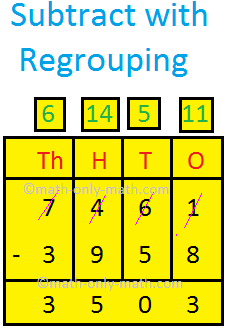
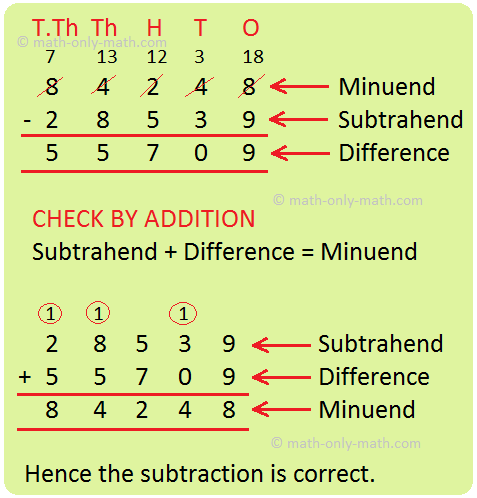
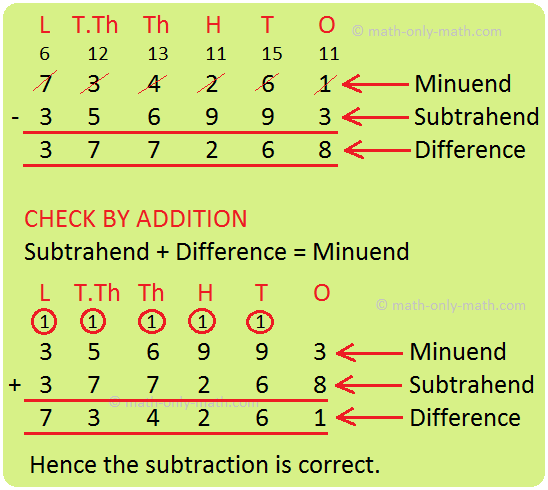
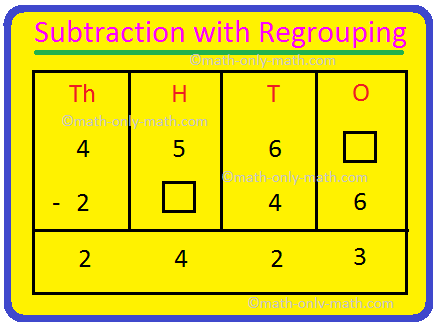
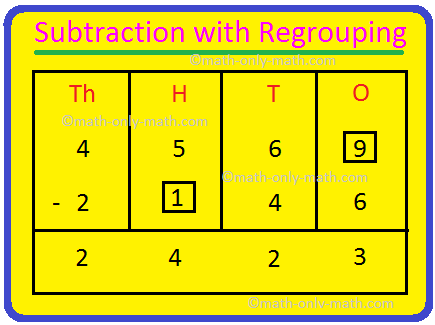
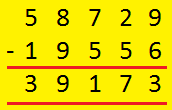
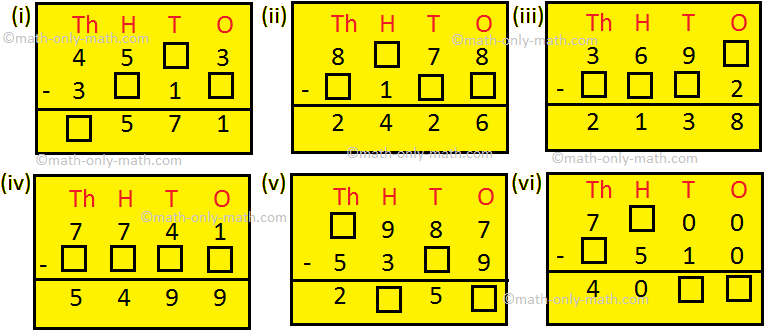



New! Comments
Have your say about what you just read! Leave me a comment in the box below. Ask a Question or Answer a Question.